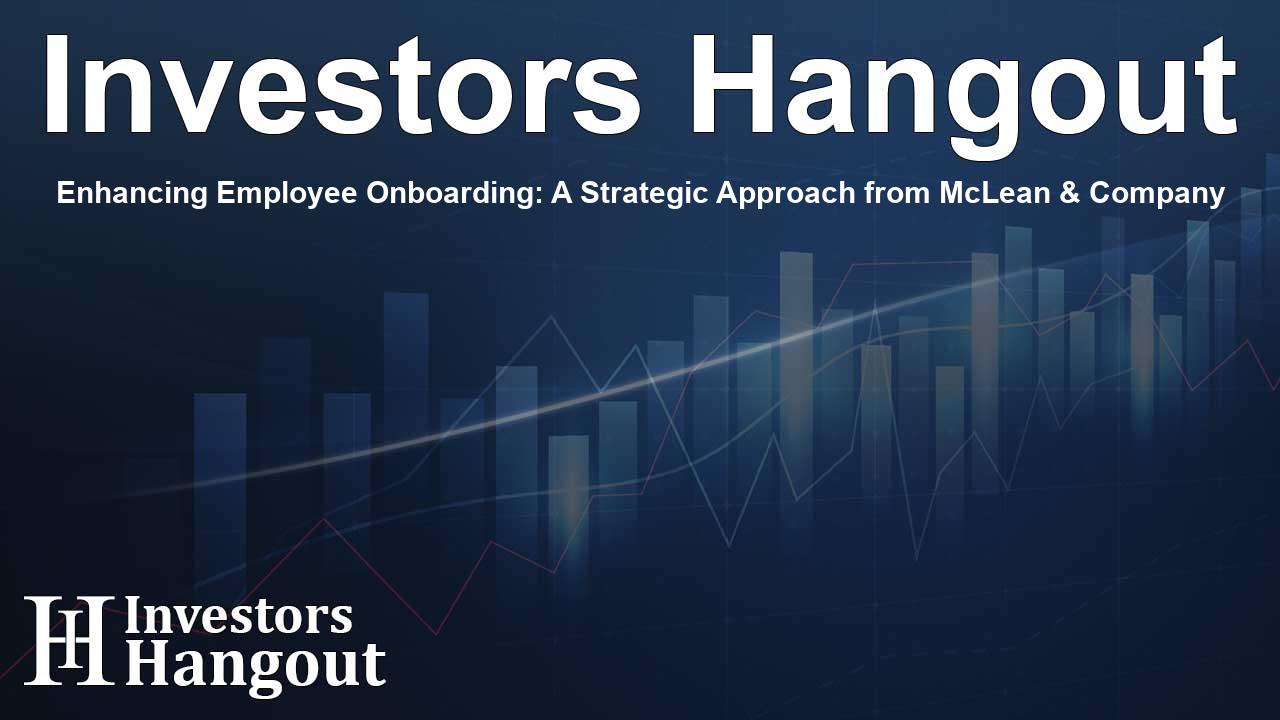Enhancing Employee Onboarding: A Strategic Approach from McLean & Company

Transforming Employee Onboarding for Long-Term Success
McLean & Company, a renowned global HR research and advisory firm, has unveiled an insightful resource titled Develop a Comprehensive Onboarding Program. This resource is designed to equip HR leaders with valuable research insights and effective strategies to create engaging onboarding experiences. By moving beyond simple orientation, organizations can develop new hires that contribute meaningfully to their teams, leading to better retention and productivity.
Understanding the Importance of Onboarding
First impressions are crucial in the workplace. However, many organizations still perceive onboarding as an abbreviated process. Unfortunately, this oversimplification often results in missed opportunities to connect with new talent and sustain their engagement. McLean & Company's research indicates that viewing onboarding as a continuous, multi-month journey is fundamental. This approach not only accelerates early contributions from new employees but also ensures they feel integrated into the larger team.
The Shift Towards Intentional Onboarding
As the landscape of the workplace evolves, McLean & Company emphasizes that onboarding needs to be a strategic initiative shared by both HR and leadership. Kelly Berte, the practice lead, highlights that effective onboarding can foster culture, clarity, and commitment. When organizations involve managers in the onboarding process instead of delegating it solely to HR, they can enhance connection and mitigate the likelihood of turnover.
Components of an Effective Onboarding Program
Research from McLean & Company outlines critical features that successful onboarding programs should integrate:
1. Clarity in Expectations
One of the primary goals of onboarding is to help new employees understand their roles effectively. Clarifying what is expected from them and how they can succeed is vital to shortening their ramp-up time.
2. Enhancing Retention through Connection
Onboarding should also focus on fostering a sense of belonging among new hires. When employees feel connected to their workplace culture and their colleagues, they are more likely to stay with the company long-term.
3. Socialization of Culture
Intentionally introducing new hires to the company culture and brand enhances their understanding and alignment with organizational values, which helps reinforce a positive work environment.
Five-Step Process for Effective Onboarding
McLean & Company's resource provides a structured five-step framework to develop a comprehensive onboarding program that aligns with business needs:
- Assess the existing onboarding experience and establish success metrics.
- Acclimate new hires by providing essential organizational, administrative, and cultural information.
- Guide employees with clear performance expectations and coaching from day one.
- Support new hires with development opportunities that align with their specific roles.
- Communicate the onboarding program effectively to ensure consistent application across the organization.
Adapting to Modern Workplace Dynamics
As workplaces continue to adapt to changing models, McLean & Company's updated resource addresses the essentials of effective onboarding in decentralized teams. It emphasizes the importance of embracing technology and tailoring onboarding programs to fit different regional or role complexities. For organizations vying for top talent, creating a strategic onboarding framework is crucial to align new employees’ expectations with reality.
Training and Resources Available
McLean & Company also offers a workshop aimed at assisting HR leaders in applying these principles within their organizations. This hands-on approach can help to bring theory into effective practice, ensuring that onboarding programs genuinely meet both employee and organizational needs.
A Commitment to Continuous Development
Furthermore, McLean & Company's blueprint provides customizable tools and diagnostics to help HR teams identify gaps in their onboarding processes and enhance their programs. Whether employees work in-office, remotely, or in a hybrid model, these tools are vital to ensuring effective onboarding.
Frequently Asked Questions
What is the main focus of McLean & Company's onboarding resource?
The resource aims to help HR leaders build engaging onboarding programs that extend beyond orientation, improving retention and productivity.
Why is onboarding considered a continuous process?
Onboarding should start once a candidate accepts the offer and continue for several months to foster effective engagement and adjustment.
What are the key benefits of an effective onboarding program?
Effective onboarding improves time to productivity, strengthens retention, and reinforces company culture.
How can organizations adapt onboarding to modern work models?
Organizations should leverage technology and tailor onboarding programs to suit hybrid work settings and different team structures.
What support does McLean & Company offer for organizations?
McLean & Company provides workshops, tools, and diagnostics to enhance onboarding practices and address existing gaps.
About The Author
Contact Ryan Hughes privately here. Or send an email with ATTN: Ryan Hughes as the subject to contact@investorshangout.com.
About Investors Hangout
Investors Hangout is a leading online stock forum for financial discussion and learning, offering a wide range of free tools and resources. It draws in traders of all levels, who exchange market knowledge, investigate trading tactics, and keep an eye on industry developments in real time. Featuring financial articles, stock message boards, quotes, charts, company profiles, and live news updates. Through cooperative learning and a wealth of informational resources, it helps users from novices creating their first portfolios to experts honing their techniques. Join Investors Hangout today: https://investorshangout.com/
The content of this article is based on factual, publicly available information and does not represent legal, financial, or investment advice. Investors Hangout does not offer financial advice, and the author is not a licensed financial advisor. Consult a qualified advisor before making any financial or investment decisions based on this article. This article should not be considered advice to purchase, sell, or hold any securities or other investments. If any of the material provided here is inaccurate, please contact us for corrections.
